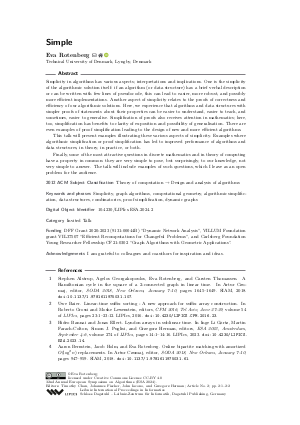@InProceedings{rotenberg:LIPIcs.ESA.2024.2,
author = {Rotenberg, Eva},
title = {{Simple}},
booktitle = {32nd Annual European Symposium on Algorithms (ESA 2024)},
pages = {2:1--2:2},
series = {Leibniz International Proceedings in Informatics (LIPIcs)},
ISBN = {978-3-95977-338-6},
ISSN = {1868-8969},
year = {2024},
volume = {308},
editor = {Chan, Timothy and Fischer, Johannes and Iacono, John and Herman, Grzegorz},
publisher = {Schloss Dagstuhl -- Leibniz-Zentrum f{\"u}r Informatik},
address = {Dagstuhl, Germany},
URL = {https://drops.dagstuhl.de/entities/document/10.4230/LIPIcs.ESA.2024.2},
URN = {urn:nbn:de:0030-drops-210739},
doi = {10.4230/LIPIcs.ESA.2024.2},
annote = {Keywords: Simplicity, graph algorithms, computational geometry, algorithmic simplification, data structures, combinatorics, proof simplification, dynamic graphs}
}

 Creative Commons Attribution 4.0 International license
Creative Commons Attribution 4.0 International license
